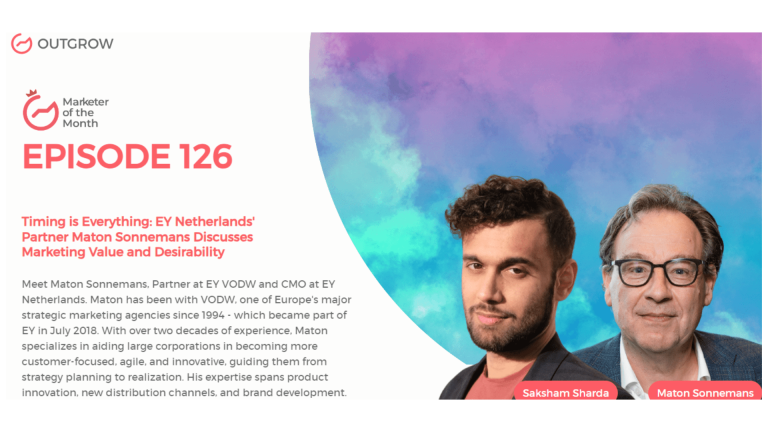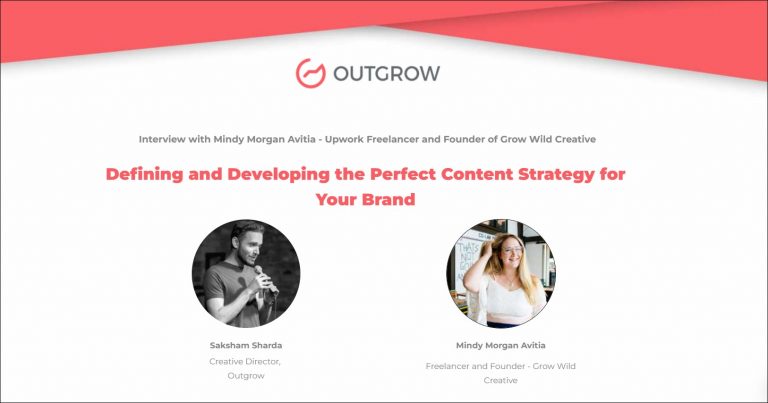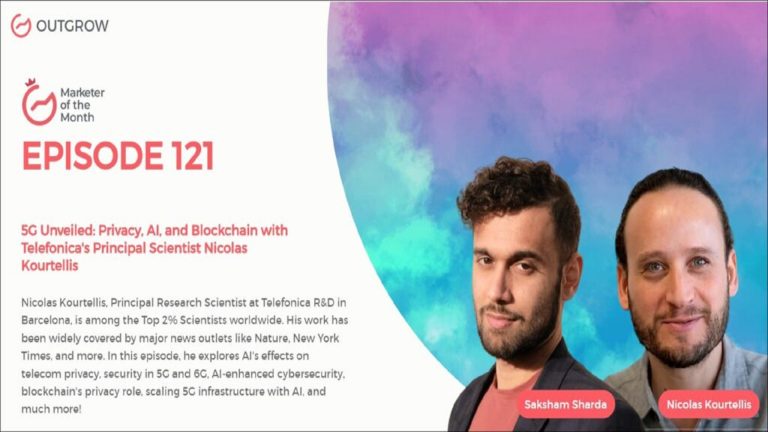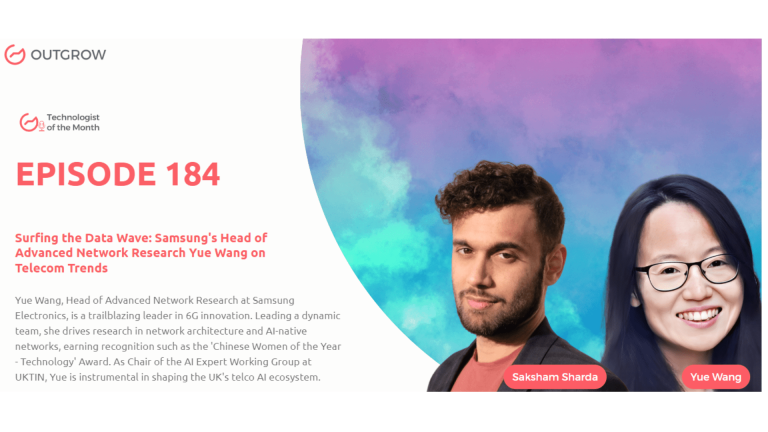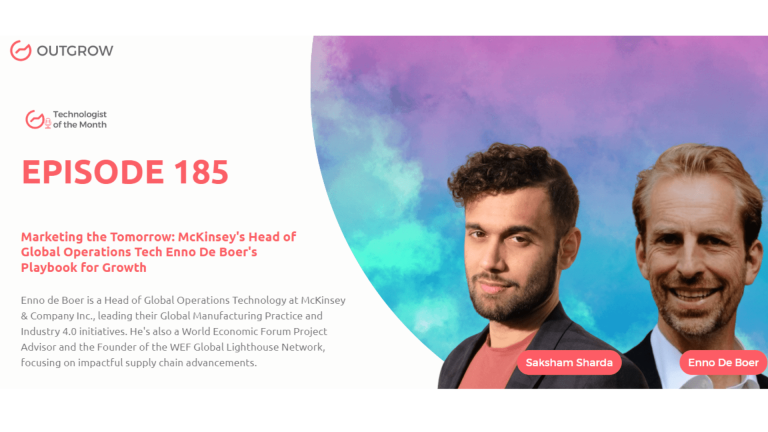EPISODE 224: Marketer of the Month Podcast with Kasia Jablonska
Table of Contents
Hey there! Welcome to the Marketer Of The Month blog!
We recently interviewed Kasia Jablonska for our monthly podcast – ‘Marketer of the Month’! We had some amazing insightful conversations with Kasia and here’s what we discussed about –
1. Using data-driven insights for content and audience decisions.
2. Adapting content to regional audience preferences for higher success.
3. Innovative ad formats attract smaller advertisers.
4. Integration with existing broadcaster models for sustainable growth.
5. Optimizing workflows with technology, processes, and collaboration.
6. Reintroducing older content to new audiences at lower costs.
About our host:
Dr. Saksham Sharda is the Chief Information Officer at Outgrow.co. He specializes in data collection, analysis, filtering, and transfer by means of widgets and applets. Interactive, cultural, and trending widgets designed by him have been featured on TrendHunter, Alibaba, ProductHunt, New York Marketing Association, FactoryBerlin, Digimarcon Silicon Valley, and at The European Affiliate Summit.
About our guest:
Kasia Jablonska is the Director of Digital and OnDemand at BBC Studios Ltd, overseeing product development, content strategy, and curation for B2B2C/B2C players and FAST channels across EMEA. With executive-level expertise in commercial strategies, business development, and digital monetization, she has driven multimillion-dollar revenues and strategic partnerships at leading media companies, including Endemol Shine, NBCU, and Scripps.
Localize, Optimize, Monetize: BBC’s Director of Digital & OnDemand Kasia Jablonska on FAST Marketing
The Intro!
Saksham Sharda: Hi, everyone. Welcome to another episode of Outgrow’s Marketer of the Month. I’m your host, Dr. Saksham Sharda, and I’m the creative director at Outgrow. co. And for this month we are going to interview Kasia Jablonska who is the Director of Digital and OnDemand at BBC Studios Ltd.
Kasia Jablonska: Great to be here. Thank you.
Don’t have time to read? No problem, just watch the Podcast!
Challenge yourself with this trivia about the exciting topics Kasia Jablonska covered in the podcast.
Or you can just listen to it on Spotify!
The Rapid Fire Round!
Saksham Sharda: Let’s start with the rapid-fire round, just to break the ice in case you don’t want to answer a question, you can just say pass. But try to keep your answers to one word or one sentence only. Alright, So the first one is, at what age do you want to retire?
Kasia Jablonska: Around 70.
Saksham Sharda: How long does it take you to get ready in the mornings?
Kasia Jablonska: Half an hour.
Saksham Sharda: Most embarrassing moment of your life?
Kasia Jablonska: God that’s a good one. I don’t walk with somebody who is quite famous and I didn’t recognize him for eight months.
Saksham Sharda: Favorite color?
Kasia Jablonska: Yellow.
Saksham Sharda: What time of day are you most inspired?
Kasia Jablonska: Mornings.
Saksham Sharda: How many hours of sleep can you survive on?
Kasia Jablonska: Eight. I need eight.
Saksham Sharda: The city in which the best kiss of your life happened?
Kasia Jablonska: Paris.
Saksham Sharda: Pick one. Mark Zuckerberg or Elon Musk?
Kasia Jablonska: God, there’s no contest Mark Zuckerberg
Saksham Sharda: How do you relax?
Kasia Jablonska: I walk a lot.
Saksham Sharda: How many cups of coffee do you drink per day?
Kasia Jablonska: I am Matcha person.
Saksham Sharda: A habit of yours that you hate.
Kasia Jablonska: I talk too much.
Saksham Sharda: The most valuable skill you’ve learned in life.
Kasia Jablonska: Listen.
Saksham Sharda: Your favorite Netflix show.
Kasia Jablonska: Good place.
Saksham Sharda: Morning routine are you an early riser or a night owl?
Kasia Jablonska: Very early riser.
Saksham Sharda: One-word description of your leadership style.
Kasia Jablonska: I’d like to think empathic, but it’s a learning game.
Saksham Sharda: The top priority in your daily schedule.
Kasia Jablonska: Make sure I hug my son in the morning.
Saksham Sharda: Ideal vacation spot for relaxation.
Kasia Jablonska: Mountains to walk in.
Saksham Sharda: Key factor for maintaining a work-life balance.
Kasia Jablonska: Don’t take yourself too seriously.
Saksham Sharda: Okay, well that was the end of the rapid-fire round. The only question I have remaining is where do you get your son in the UK?
Kasia Jablonska: Where do I get my son In the UK? No, sorry. I meant like hug my 8-year-old son in the morning.
Saksham Sharda: Oh, You do mean like a real son.
The Big Questions!
Saksham Sharda: It’s okay. Let’s go into the long-form questions, which you can answer with as much time and ease as you like. The first one is, how do you leverage business intelligence to guide decision-making in digital and on-demand operations?
Kasia Jablonska: So business intelligence is really important to us. We make a many data-driven decision across all levels of operations. It definitely wasn’t like this historically, like, just to give an example of fast. Historically, we would just hand the content over to FAST platforms, hope for the best, and pick up the check every couple of months. Now things are definitely changing. BBC has invested in our own data platform where we aggregate data from various sources and turn it into the dashboard. And it’s helping us to sort of, to form kind of to make a sort of informed decisions across markets, products and all that. Why do we do it? What are the kind of the, the key reason behind it? Definitely, it helps us to develop localized strategies helps us to understand regional audience behaviors. So to give you a few examples, in Italy and France for example, we introduced drama channels because we were able to sort of identify that with the preferences of the local audiences. And in Germany, we went with a history channel because again, it helped us to understand that those were the preferences of the local audiences. In Nordics, we introduced E-standers on the player, even though the show has never been on any linear television. And because of that, actually, the show is performing really well because we were able to identify the audience. So localized strategies UI promotions are very useful when managing content discovery across UI. We are getting better at understanding UI features on different partners and the usage of data is definitely helping us with this. Also, we use BI not only for retrospectives but also kind of we leverage it for predictive analytics, forecast audiences, trends, etc. It’s helping us to unlock more valuable tips as we are able to predict the return on investments.
Saksham Sharda: And so what are the unique challenges and opportunities of overseeing this kind of product development and content strategy for FAST channels?
Kasia Jablonska: I would say it is a mix of agility and creativity when kind of, when you look at this, so balancing your audience engagement with commercial growth making sure you use data for those kinds of quick decisions, but at the same time you continue updating your legacy systems and workflows. So the three key opportunities I see here the niche channel development, increasing the IP lifecycle, and creating new advertising revenue opportunities. So for niche channels development fast an ideal playground for niche channels. You know, you’ve got your single IP channels, like in our case, top Gear and Dr. Who you’ve got your genre-specific channels like BBC Earth, Food History, and Travel. This creates opportunities for kind of a highly targeted audience and highly targeted monetization when it comes to increasing the IP lifecycle. We can maximize the lifecycle of our deep libraries. We kind of, re-introduce them to the new audiences and we do it at comparatively lower costs to other distribution methods. You know, as the kind of content sells, the value decreases in all the Windows, FAST gives us this opportunity to kind of shift it and introduce it to those new audiences. And then when it comes to add revenues, there is a growing shift of advertisers sort of shifting towards streaming and our digital products like Fast and Player represent and grow kind of of those kinds of revenue on streaming. So great opportunity for smaller advertiser who advertisers who up till now were not able to afford TV advertising FAST does not require fixed, fixed budget commitments. And the pricing is relatively low in comparison with big TV sort of advertising budgets. Also, you’ve got lots of innovative formats like dynamic advertising, contextual advertising, shoppable ads, and all of this is coming. And then when it comes to challenges, again, I would say three lack of industry standards, localization and technology, lack of industry standards. It’s a relatively young industry with the kind of standards as just being created as we speak. So there is a limited visibility of commercial data. There is no single currency, there isn’t a kind of visibility of the end-to-end value chain when it comes to kind of stakeholders in this programmatic process. A lot of advertisers are still mistrustful, but, as the industry kind of matures, this will continue shifting. Localization is extremely important, but also quite expensive as you can imagine. So you need your local language versions, you need to understand your local environment, sort of regulatory environment. And obviously you need to invest also in local content. And then like in all cases of technology-made media, it takes a while to have scalable tech solutions. So we are working very closely with our technology teams to introduce right, tools like deep digital repositories, metadata solutions, AI-driven scheduling tools, etc.
Saksham Sharda: And so besides these, what else do you think will define the future of F Channels?
Kasia Jablonska: I would say definitely markets on its own. It will basically decide where the importance of Fast in the kind of the bigger picture. The forecast is that by 2028 EMEA region will be delivering about $1 billion of revenue for FAST, but it’s not particularly clear where this revenue will be coming from. So EMEA obviously is very different than the US landscape. So I think it will be very much a decision of the key players, how FAST we fit into this bigger picture. So EMEA, we have a much stronger broadcasting base than in us. And the four, I think the broadcaster in many ways will decide what’s going to happen with FAST. They have a very strong pivot platform where they monetize their own content through sometimes even ESD. So I have a strong suspicion that the model will develop very much similar to what Netflix or Disney Plus is doing at the moment, where FAST will become just one of the revenue models on this platform. Probably a sort of a lower, less paid tier or like a sort of a bit of a, you know, package in front of the wall. But I genuinely think that it will be kind of absorbed in this bigger broadcast people strategies.
Saksham Sharda: So in general then, what are the key factors to consider when developing strategies to grow and engage audiences?
Kasia Jablonska: Definitely understanding audience, good sort of hang of who your audiences are so you can deliver, sort of develop personalized strategies. FAST data is still quite patchy, so it’s difficult to get a full socioeconomic profile of our viewers, but we’re lucky that we also have other products in our roots to markets like linear channels, and players we gather this first-party data from different markets, different platforms, and we buy the cross-references and are slowly forming a picture who our audiences are. Uso for example, Nordic probably is one of the best markets because we have multiple different products that market like Lia, channel players, and, we, like, one of the things, for example, we understand is that the prime time for each of those products. So we can kind of strategy and develop to support each other. The other important element I would say is quality content. So it’s compelling relevant, diverse content. BBC Studio is one of the largest distributors of UK content. We have almost 54,000 hours of content in our catalog. It’s a huge base to kind of for building our digital products. And we are very dedicated on kind of creating on having a very strategic content curation and delivering kind of, you know, spoke strategies across different products. And just to, again, give an example from Fast Channel, we have our single IP channels, like Top Gear, basically factual entertainment moments. But we also have Doctor who is very kind of dedicated to super fans of the genre and BBC which was developed on the back of sort of the, the kind of the recent environmental trends. Another factor is leveraging multiple routes to market. Every platform and every model is different. Again, we have to make sure we have the most different platforms and we basically try and test to see what works well and the kind of partnership, the promotional opportunity with different partners. It’s been a steep learning curve with linear channels. We rely heavily on paid media campaigns and B2B promotion with fast players. It’s very much focused on UI promotion and content merchandising. So we found ourselves reliant suddenly on t thumbnails and metadata optimization, something the business hadn’t been originally set up for. So we, we really had to quickly address this.
Saksham Sharda: And so in all this, how do you balance shaping a strategic vision while remaining hands-on during execution?
Kasia Jablonska: Well, I think it very much is a learning process. It is a lifetime process. So I would say I’m trying to balance a combination of kind of a clear focus, flexibility, delegation, and, at the same time, ongoing engagements. So at BBC, we build our strategies bottom up. We kind of, we clearly understand market needs and we work towards those kinds of a three to five-year plan, which helps us to balance short-term goals with long-term ones. I strongly believe in so-called blue line management when you look towards your kind of, the longer-term horizons. And I can highly recommend a book by Kaiser and Young, it’s called Blue Line Imperative. And also the other thing which is extremely important is the mastery of the basics. So there’s another really good book by Brad Brown, it’s called Dare to Lead. And it advises leaders to practice and master their fundamentals. So it’s a bit like playing football. You spend hours training how to kind of manage your foot movements and kick the ball. So once you are on the field, you don’t have to worry about it because you can look up and kind of strategize how to score. So the combination of those two, master your basics but also know your long-term goals. And for that, you definitely need to focus on your priorities. We do know where we want to be in three to five years now, and we have to make sure we, everybody knows why we stay hands-on when it comes to you know when it comes to critical milestones like content strategies, monetization framework, regular targets, reviews, but stay hands off when it comes to team management. You need to put obviously a clear framework around people’s responsibilities and then, then you kind of let them go, make them autonomous. I feel like sometimes I’m a bit like a waiter I hover around to kind of provide the support when needed, but at the same time leave them to kind of, get on with this. And that kind of helps not only empowers them and helps them develop their skills, but gives me the bandwidth so I can focus on the bigger picture.
Saksham Sharda: And so how would you summarize your approach to driving also business transformation and managing change itself effectively?
Kasia Jablonska: So again, I think it’s a combination of things. A combination of vision and strategy and a combination of outcomes and a people-first approach, a big focus on communication, collaboration, and flexibility but also you need a yardstick for your outcomes and you need to be able to celebrate progress. And someone once said that one thing we forget about, in transformation is that people spend a lifetime learning how to work on specific technologies and it’s really difficult to retrain them. So whilst technology, progress is exponential, no matter how fast the technology changes, it’s this change in people to move them from one piece of kit to another that may be extremely difficult, but you definitely need to defy your why. My boss is very clear. We always have to start with why, are we investing in those new ways of monetizing content. Why do we think people will agree to spend time prepping and delivering assets using unknown systems and processes? I always have to make sure I make people excited about our vision and why we kind of growing this digital business make sure you engage your key stakeholders and by key stakeholders, I mean both the leadership team and also your colleagues. I have to be very clear about my blue line and spend my time lobbying for it. We know that three to five years from now, 20% of our revenues should come from those kinds of new digital models. And we have to achieve early visible wins to build the momentum. So in the first year when we kind of first launched, we had 10 fast channel feeds in the markets. Two years later, we now have seven fast brands across 23 channel fits, and we are in 42 countries. So that kind of speaks for itself. Also really important is this culture of flexibility and you know, as I said, resilience is natural. People spent years mastering certain skills and now you tell them those skills are not important anymore. You have to learn something new. So this kind of active empathic listening is tough. It’s really tough, but it’s very important. It took me a while to arrive there, but luckily I had good mentors. So as soon as I switched from telling people what to do to kind of listening to their suggestions, things definitely became easier.
Saksham Sharda: And so how do you yourself stay ahead of shifting market trends in the on-demand and digital landscape?
Kasia Jablonska: Definitely constant monitoring. I regularly track industry reports, and competitive analysis to basically understand what those trends are, and what’s happening in the markets. A few of my favorites I would say include the great British think tank, DPP, amazing reports, amazing events, and three visions. One of my favorite industry sort of influencers is Mario Ette and her streaming made it easy and also question time. I attend multiple industry forums, conferences, and panelsMidcom, obviously, IBC also connected TV, summit Digital summit. It really kind of helps me to exchange ideas and kind of stay informed.
Saksham Sharda: And how do you navigate risk when trying to adopt any of these new trends?
Kasia Jablonska: Again, it’s about I would say testing, testing, and learning. You know, the risk is always there. And as I said, you have your kind of a blue line, you have your horizon, and you know where you want to arrive. We are very clear also about our strategy. We put certain forms in sort of certain formats in place and we kind of know where we want, what are the immediate steps, what are the long-term steps. But then once we kind of have this, framework, people understand what everybody’s supposed to do. It’s a test to learn and sometimes you have to take a leap of faith, but we know the environment is very much controlled for us to be able to do it. Also, just basically trust between the team members knowing that somebody has your back. If somebody goes wrong, that’s not go, there’s not going to be a blame culture. But this is basically this kind of an ongoing learning process. We, you know, that there is a feedback loop where we know every time, every pro something happens, projects we need, we have post more tabs where we understand what went wrong, what didn’t go wrong, and what went well. And then the ongoing feedback. So I would say this is extremely important just to make sure you kind of control your risks, but at the same time it’s such a new field, such a new fast developing area, you have to be able to take those calculated risks.
Saksham Sharda: So speaking of operations then what processes do you use to achieve operational excellence in end-to-end commercial operations?
Kasia Jablonska: I would say it definitely is about combining structured processes investing in technology, cross-function, and collaboration. But again, another thing I’m quite sort of keen on is this kind of continuous improvement there. The Japanese Kaizen style. So every phase of commercial operations from content delivery to monetization needs to be optimized for kind of efficiency and commercial impact. So first of all, we are making sure that everything is integrated. We kind of, we are trying to deliver a seamless integration of tools across the value chain. So content management, analytics, monetization platform. The aim is to kind of improve information visibility to make it easy and smooth for everybody to deliver cloud-based solutions and automation. Shifting asset storage and processes to the cloud again, to ensure consistent and easy access to our content-updated supply chain. We work very closely with the technology team to make sure that the new supply chain includes solutions for our digital deliveries like metadata management tools or the cloud-based asset storage depository, and then close functional collaboration. Again, it kind of goes down to people. Ops is at the heart of commercial delivery whilst linear content delivery is disconnected from commercial side effects in the case of digital revenues and has a direct impact on monetization. So, you know, as I mentioned before, ongoing feedback loops, continuous feedback to stakeholders to kind of, identify bottlenecks. We track the workload of individual team members and we know how long each stage takes to be able to plan ahead and postmortems for every major kind of project campaign we meet, we conduct retrospective help kind of, and it helps us to capture what needs to be improved.
Saksham Sharda: And how does your empathetic leadership style, you know, help all this help foster connections and also help drive business outcomes?
Kasia Jablonska: Well, as I was saying, I like to think that I am empathetically that, it’s a journey. It’s, it’s not a destination, that’s for sure, and you constantly need to catch yourself. It, it’s not only about building relationships, but it is a kind of strategic approach to kind of driving engagement, collaboration, and then kind of managing business outcomes maybe empathetic leadership and performance management seem like two very kinds of odd couples, but if you combine them effectively in deliveries, a very strong, very powerful framework for kind of for delivering growth, accountability, and high performance. So make sure you show empathy in goal setting. So take your time to understand team members strengths, challenges, and their career inspirations. Make sure you provide constructive feedback. So, it’s a two-way dialogue that if there are some areas for improvement, make sure you balance it with a kind of acknowledging strength and make sure you understand how your team members feel. And balance accountability with understanding. So yes, you need to hold your team accountable, eh, empathy doesn’t mean you have to lower your standards, but you have to balance the high expectations with fairness and recognize valid reasons if something sort of went wrong. And if there is this underperformance view it as an opportunity to coach and also continue encouraging ownership and autonomy. And, you know, I like to say I always give people enough rope to hang themselves. Also, it is sort of making sure to get enough responsibility for the right stage of everybody’s career. They, some people when I just check stuff at them and they go, brilliant, give me more. But there are some people who look at this and basically start panicking. So I just have to give them things in smaller chunks and then recognize and celebrate contributions, no matter how big or small they are.
Saksham Sharda: So considering everything we’ve discussed today, where do you think the future of content production is headed from your perspective?
Kasia Jablonska: Oh, that is an interesting one. I think it is a creator economy. I strongly believe it’s a real thing. It’s going to get bigger and bigger. As you know, YouTube is already one of the biggest sort of OTT platforms. I think the production on its own is because of the technology, because of digitalization, it’s going to get cheap. So I think there will be lots of kind of cross opportunities between the kind of the old Hollywood all kind of style of production and the creators economy and come up with much more kind new better ideas. So I think it’s just a combination of those two technologies and basically more kinds of people delivered deas blockchains, I would say that is also something I’m quite interested in and how blockchain technology is going to help finance production. I strongly believe that this is coming where, producers will be able to just throw ideas out there and then self-produce, and gather money through crowd funding thanks to the kind of blockchain technology so everybody can participate and take their share of the proceeds.
Saksham Sharda: Yeah, it sounds fascinating. So the last question for you is of a personal kind. What would you be doing in your life? If not this
Kasia Jablonska: A really interesting question. I think if it wasn’t for this, I probably would’ve ended up at university teaching languages.
Saksham Sharda: That’s amazing. Okay. So one day I shall interview you for linguist of the month
Kasia Jablonska: Yes, you never know.
Let’s Conclude!
Saksham Sharda: Thanks, everyone for joining us for this month’s episode of Outgrow’s Marketer of the Month. That was Kasia Jablonska who is the Director of Digital and OnDemand at BBC Studios Ltd.
Kasia Jablonska: Pleasure. Thanks for having me.
Saksham Sharda: Check out the website for more details and we’ll see you once again next month with another marketer of the month.
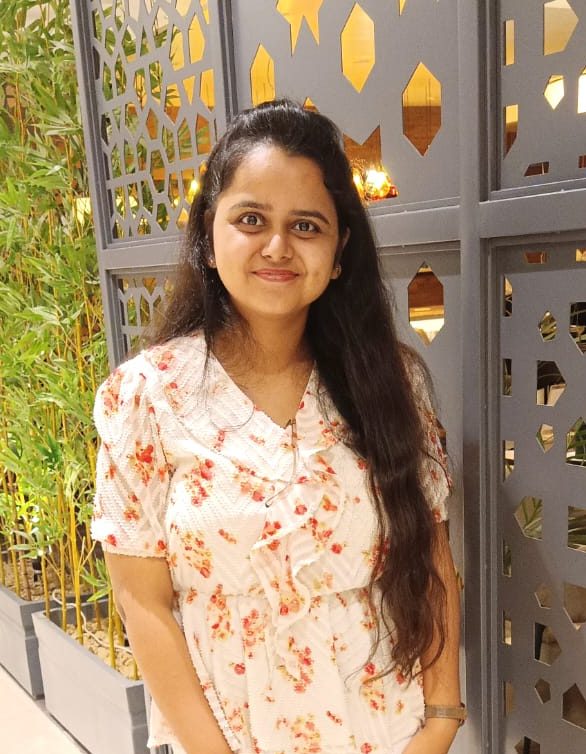
Muskan is a Marketing Analyst at Outgrow. She is working on multiple areas of marketing. On her days off though, she loves exploring new cafes, drinking coffee, and catching up with friends.




